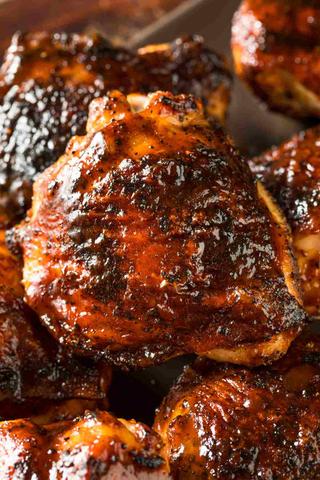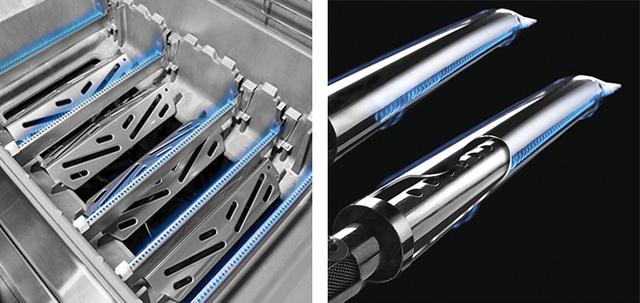
“Unlocking the Secrets of Tender Perfection: Discover the Optimal Internal Temperature for Boneless Chicken Thighs”
Internal Temp of Chicken Thighs: With Actual Testing (Go Above 165F!)
When it comes to cooking chicken, it is important to understand that white meat and dark meat require different cooking methods. Chicken thighs, which are considered dark meat, should be cooked well beyond the recommended internal temperature of 165F. In fact, they should be pushed into the territory of 200F in order to allow the collagen and connective tissue to break down and render. This process results in moist and juicy meat with gelatinized collagen and crispy skin.

The difference between white meat and dark meat lies in their myoglobin content and skeletal muscle fiber. Dark meat, like chicken thighs, contains more myoglobin due to its slow-twitch muscle fibers. These muscles are used for extended periods of time by the bird, requiring a consistent energy source like oxygen. On the other hand, white meat such as chicken breast is made up of fast-twitch muscle fibers that require less oxygen for function.
Chicken thighs contain a higher amount of collagen compared to breast meat. Collagen is a protein found in bones, skin, cartilage, and muscles, and it is an essential component of connective tissue. Studies have shown that the tenderness of meat is negatively correlated with collagen content. Therefore, cooking chicken thighs to just 165F results in less tender meat compared to higher finishing temperatures.
Chicken Thighs are Dark Meat

Chicken thighs are considered dark meat due to their myoglobin content and the composition of slow-twitch muscle fibers. These muscles are used for extended periods of time, such as sitting, standing, and walking. Dark meat contains more myoglobin, which gives it a reddish hue compared to white meat. In contrast, chicken breast contains fast-twitch muscle fibers and very little myoglobin.
Collagen is a protein found in bones, skin, cartilage, and muscles. Chicken thighs have higher collagen content compared to breast meat. Cooking chicken thighs to 165°F results in less tender meat because the collagen has not fully broken down. To achieve tenderness in chicken thighs, it is necessary to render the collagen and connective tissues through both time and temperature. The lowest possible temperature for collagen conversion is 131°F, but higher temperatures result in faster denaturing of collagen.
Cooking chicken thighs to temperatures above 165°F allows the collagen to break down further, resulting in more tender meat that pulls away from the bone. It also leads to the rendering of skin fat, creating crispy and crackly skin. By cooking the thighs at higher internal temperatures, more fat is rendered from under the skin and collagen is broken down. This improves both the texture and flavor of the chicken thighs.
Chicken Thighs and Collagen Content

Chicken thighs contain a higher amount of collagen compared to chicken breast meat. Collagen is a protein found in bones, skin, cartilage, and muscles, and it is an essential component of connective tissue. A case study by Chen Y et al. showed that regardless of chicken breed, the total collagen content in thigh meat was always greater. The tenderness of the meat was found to be negatively correlated with collagen content. Therefore, cooking chicken thighs to a temperature of 165°F, which is considered safe but does not fully render the collagen, results in less tender meat.
In order to improve the tenderness of chicken thighs, it is necessary to render the collagen and connective tissues. The rendering of collagen requires both time and temperature. The lowest possible temperature for collagen conversion is 131°F. However, simply increasing the temperature of the cooking environment does not automatically render the collagen. To properly render the collagen in chicken thighs, they should be cooked to around 160°F and then held between 160-200+°F for a certain period of time. This process allows the collagen and connective tissue to break down, resulting in more tender meat.
Chicken skin contains fat and connective tissue (collagen) which can contribute to its rubbery texture when not properly rendered. By cooking chicken thighs to higher internal temperatures, more fat is rendered from under the skin and the collagen breaks down. This results in better fat render under the skin and crispy/crunchy skin texture. To achieve even crispier skin on chicken thighs, consider air drying and salting the skin overnight before cooking.
Rendering Collagen in Chicken Thighs: Time and Temperature
When cooking chicken thighs, it is important to understand the process of rendering collagen. Collagen is a protein found in bones, skin, cartilage, and muscles, and it is an essential component of connective tissue. Chicken thighs contain a higher amount of collagen compared to breast meat, making them less tender when cooked to the standard internal temperature of 165F.
To achieve tender and moist chicken thighs, it is necessary to break down the collagen through a combination of time and temperature. The lowest possible temperature for collagen conversion is 131F, which coincidentally aligns with the USDA’s recommended temperature for reducing harmful bacteria like Salmonella. However, simply searing the chicken thighs to 200F won’t render the collagen; they need to be held between 160-200+ degrees Fahrenheit for a certain period of time.
In addition to rendering collagen, cooking chicken thighs to higher internal temperatures also results in better fat rendering from under the skin. This helps create crispy and crunchy skin that is often desired in dishes involving skin-on chicken. To enhance the texture of the skin even further, consider air drying and salting the skin overnight or adding a small amount of corn starch to your rub.
Skin-on Chicken Thighs
When cooking skin-on chicken thighs, it is important to understand that the skin plays a significant role in the texture and taste of the final dish. The fat under the skin, along with collagen, contributes to the crispy and crunchy texture of the skin. To achieve this desired texture, it is recommended to cook the chicken thighs to an internal temperature of at least 185F.
At 165F internal temperature, the fat under the skin is not completely rendered and may be chewy or rubbery. Additionally, while the meat remains juicy, there is a lack of tenderness. However, at 185F internal temperature, the fat under the skin is rendered much better, resulting in a more enjoyable eating experience. The meat becomes tender and juicy, although there is still room for improvement.
If you are aiming for pull-apart, tender meat with crispy/crunchy skin, it is suggested to cook the chicken thighs to an internal temperature of 200F or above. At this temperature range, there is even better fat rendering and the skin achieves a crispy/crunchy texture. The gelatinization of collagen keeps the meat moist while enhancing the quality of the skin.
Testing Various Chicken Thigh Finishing Temperatures

When it comes to cooking chicken thighs, the finishing temperature plays a crucial role in the texture and tenderness of the meat. While the USDA recommends a minimum internal temperature of 165F for safety reasons, pushing the temperature well beyond this can result in more flavorful and tender chicken thighs.
In a series of tests, chicken thighs were cooked at different finishing temperatures to determine the optimal level for collagen rendering and connective tissue breakdown. At an internal temperature of 165F, the chicken thighs were still somewhat chewy and lacked tenderness. However, at 185F, there was a noticeable improvement in fat rendering and tenderness. The skin also became more bite-through. Finally, at 200F, the fat was rendered even better and the skin achieved a crispy and crunchy texture.
The higher temperatures allowed for greater collagen breakdown, resulting in moist and tender meat that easily pulled away from the bone. It’s important to note that simply searing the chicken thighs at 200F won’t achieve the same results; both time and temperature are necessary for proper collagen rendering.
Chicken Thigh at 165F
When cooking chicken thighs to an internal temperature of 165F, the fat under the skin is not completely rendered and remains chewy and rubbery. While the meat is still juicy, it lacks tenderness. The collagen in the thighs has not fully broken down at this temperature, resulting in less tender meat.
Chicken Thigh at 185F
When cooking a chicken thigh to an internal temperature of 185F, the fat under the skin is rendered much better compared to when cooked to 165F. The skin becomes crispy and easy to bite through. In terms of tenderness, the meat is juicy and tender, although there is still room for improvement. Overall, cooking chicken thighs to 185F results in a good balance between rendered fat, crispy skin, and tender meat.
Chicken Thigh at 200F
Cooking chicken thighs to an internal temperature of 200F results in crispy and crunchy skin. The collagen in the thighs breaks down, rendering the fat under the skin and creating a more tender and moist meat. The gelatinization of collagen keeps the meat juicy while improving the texture of the skin. This higher temperature also allows for better fat render, resulting in a more flavorful and enjoyable eating experience.
Closing Thoughts
Closing Thoughts
In conclusion, cooking chicken thighs to a higher internal temperature of 200F or above is recommended for the best results. While chicken is considered safe to eat at 165F, dark meat like thighs should be pushed past this temperature to allow the collagen and connective tissue to break down and render. This not only results in more tender meat but also creates a gelatin that keeps the meat moist and improves the texture of the skin.
It’s important to note that white meat and dark meat require different cooking methods due to their composition. Chicken thighs contain more collagen than breast meat, which is why they need to be cooked at a higher temperature for optimal tenderness. Simply searing a chicken thigh to 200F won’t render collagen; it requires both time and temperature.
By cooking chicken thighs to higher internal temperatures, you also render more of the fat from under the skin, resulting in crispy and crunchy skin. Air drying and salting the skin overnight can further enhance its texture. Adding a small amount of corn starch to your rub can also help achieve crispy skin.
Overall, testing various finishing temperatures for chicken thighs reaffirms that going above 165F leads to crispier skin and more tender meat. The gelatinization of collagen keeps the meat moist while improving its overall quality. It’s always recommended to test different temperatures yourself and determine your preference for taste and texture.
In conclusion, ensuring the internal temperature of boneless chicken thighs is thoroughly cooked is essential to avoid any potential risks of foodborne illnesses. By using a reliable meat thermometer and following recommended guidelines, you can guarantee the safety and deliciousness of your chicken dishes.
Learn More About Grilling
If you want to learn more about grilling, check out these other helpful resources!









